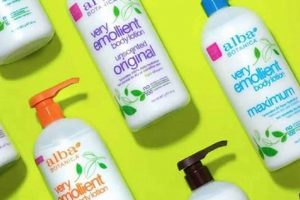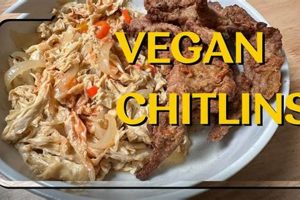The concept relates to the practice of creating body art using materials that do not contain any animal products or byproducts. This extends beyond just the inks used, encompassing stencil paper, razors, soaps, and aftercare products. For example, traditional tattoo inks may contain ingredients like bone char (for black pigment), gelatin, or shellac, all of which are derived from animals. A truly animal-free tattoo necessitates the use of alternatives, such as inks formulated with plant-based pigments and synthetic resins.
The significance of this approach lies in aligning personal values with artistic expression. For individuals adhering to a plant-based lifestyle, obtaining body art that reflects this commitment is paramount. Furthermore, it supports businesses that prioritize ethical and sustainable practices. While the practice is relatively new, its roots can be traced back to the growing awareness of animal welfare and the demand for cruelty-free consumer goods across various industries. The increasing availability of animal-free inks and supplies demonstrates a tangible shift towards inclusivity within the tattoo community.
The following sections will delve into the specific components involved in achieving truly animal-free body art, including detailed information about ink ingredients, the search for suitable supplies, and proper aftercare techniques. The importance of consulting with informed artists and verifying product information will also be discussed.
Important Considerations for Animal-Free Body Art
Achieving truly animal-free body art requires diligent research and careful selection of both the artist and the materials used. The following considerations are crucial for ensuring the process aligns with a plant-based lifestyle.
Tip 1: Research Artist Credentials: Prior to booking an appointment, investigate the artist’s knowledge and experience with animal-free tattooing. Confirm their willingness to use exclusively plant-based inks and supplies. Ask specific questions about their sourcing practices.
Tip 2: Scrutinize Ink Ingredients: Thoroughly examine the ingredients lists of all inks used. Look for certifications indicating that the inks are free from bone char, gelatin, shellac, glycerin derived from animal sources, and any other animal byproducts. Contact the ink manufacturer directly for clarification if necessary.
Tip 3: Verify Stencil Paper Composition: Traditional stencil papers may contain lanolin, a wax derived from sheep. Ensure the artist utilizes a synthetic alternative. Inquire about the composition of the stencil transfer fluid as well, as some may contain animal-derived ingredients.
Tip 4: Confirm Razor Composition: Disposable razors often feature lubricating strips containing glycerin or other animal-derived substances. Request that the artist use a razor with a lubricating strip specifically labelled as animal-free, or provide a personally sourced razor.
Tip 5: Inquire About Soap and Cleansers: Many soaps contain animal fats or other animal byproducts. The artist should use a cleanser verified to be animal-free for preparing the skin before the procedure and cleaning the tattooed area afterwards.
Tip 6: Utilize Animal-Free Aftercare Products: The aftercare phase is critical for proper healing. Select balms, lotions, and ointments that are explicitly labelled as plant-based and cruelty-free. Avoid products containing beeswax, lanolin, or tallow.
Tip 7: Request Documentation: Request written confirmation from the artist detailing the specific animal-free products used during the procedure. This provides a record for personal reference and future appointments.
Implementing these considerations will help ensure that the pursuit of body art aligns with personal values and contributes to the demand for ethical and sustainable tattooing practices.
The next segment will explore the prevalence of animal-free options in the tattoo industry and the ongoing efforts to promote greater transparency and ethical sourcing within the community.
1. Ink Composition
Ink composition represents a critical juncture in the pursuit of animal-free body art. Traditional tattoo inks often incorporate animal byproducts, rendering them incompatible with a commitment to a plant-based lifestyle. Understanding these components and their animal-free alternatives is paramount.
- Bone Char Pigment Replacement
Bone char, derived from charred animal bones, has traditionally been used to create black pigments in tattoo inks. Vegan alternatives utilize carbon black sourced from vegetable matter or synthetic sources. The identification and selection of these alternatives is vital for achieving a genuinely animal-free tattoo.
- Gelatin Binder Substitution
Gelatin, a protein derived from animal collagen, sometimes serves as a binder or stabilizer in tattoo inks. Plant-based alternatives, such as vegetable glycerin or synthetic polymers, provide similar binding properties without utilizing animal products. Scrutinizing ink labels for these substitutes is essential.
- Shellac Carrier Elimination
Shellac, a resin secreted by the lac insect, may be found in some tattoo inks as a carrier or sealant. The elimination of shellac from ink formulations necessitates the use of synthetic resins or plant-derived waxes as substitutes. Awareness of potential shellac content is crucial for ensuring compliance with vegan principles.
- Glycerin Source Verification
Glycerin, a humectant used to maintain moisture in tattoo inks, can be derived from either animal or vegetable sources. Verification of the glycerin source, ensuring it originates from plant-based oils, is necessary to avoid the unintentional use of animal byproducts. Contacting ink manufacturers directly may be required to ascertain the origin of the glycerin.
The meticulous examination and substitution of animal-derived components in tattoo ink demonstrate a commitment to ethical consumerism and animal welfare. The increasing availability of plant-based ink options reflects a growing demand for cruelty-free alternatives within the body art industry. The ongoing development and refinement of these inks contribute to the accessibility and viability of animal-free tattooing practices.
2. Supply Sourcing
Supply sourcing constitutes an indispensable element in the creation of animal-free body art. It establishes a direct causal relationship between ethical consumerism and the resulting tattoo procedure. The conscientious procurement of tattooing supplies devoid of animal products ensures the tangible realization of the animal-free ideal. Failure to prioritize responsible sourcing effectively undermines the broader goal of cruelty-free expression. For example, the reliance on conventional stencil papers containing lanolin directly contradicts the intention of a vegan tattoo, regardless of the ink’s composition.
The importance of supply sourcing extends beyond mere ingredient lists. It encompasses an assessment of the manufacturers’ overall ethical stance. Ideally, suppliers should adhere to cruelty-free testing practices and demonstrate a commitment to sustainable production. This commitment can be verified through certifications from recognized organizations advocating for animal welfare and ethical sourcing. Moreover, transparent supply chains, where the origins of each component are readily traceable, reinforce consumer confidence and accountability. A practical example involves confirming that the soap used for skin preparation is not only devoid of animal fats but also produced without animal testing.
In conclusion, supply sourcing represents a critical determinant in the attainment of genuinely animal-free tattoos. Overlooking this facet renders the process incomplete, potentially compromising the intended ethical outcome. The challenge lies in the complexity of supply chains and the necessity for diligent research. However, by prioritizing transparency, verifying certifications, and actively seeking ethically aligned suppliers, individuals can ensure that their body art authentically reflects their commitment to animal welfare. A thorough awareness of the sourcing process reinforces the integrity of the animal-free tattoo as a meaningful symbol of compassion.
3. Artist Awareness
Artist awareness forms a cornerstone in the ethical and practical application of animal-free tattooing. The level of knowledge and commitment exhibited by the tattoo artist directly impacts the authenticity and integrity of the endeavor. Without sufficient awareness, even the most well-intentioned client may inadvertently receive a tattoo that falls short of animal-free standards.
- Product Knowledge and Sourcing
An informed artist possesses a comprehensive understanding of the ingredients present in tattoo inks, stencil solutions, aftercare products, and other supplies. This knowledge extends to identifying potential animal byproducts that are often concealed or ambiguously labeled. Furthermore, the artist actively engages in responsible sourcing, favoring suppliers who prioritize ethical practices and transparent supply chains. For example, an artist demonstrating awareness will be able to definitively confirm the absence of bone char in black inks, and offer verified alternatives.
- Procedural Adaptation
Achieving a truly animal-free tattoo requires modifications to conventional tattooing procedures. An artist with sufficient awareness will adapt their techniques to accommodate the use of vegan-friendly alternatives. This may involve adjusting stencil application methods, utilizing different cleaning agents, and providing specific aftercare instructions tailored to plant-based products. The artist also understands and communicates the potential differences in application or healing associated with these alternative materials.
- Client Education and Communication
Awareness extends to the artist’s ability to effectively educate clients about the nuances of animal-free tattooing. This includes clearly explaining the ingredients and sourcing of all materials used, addressing client concerns or misconceptions, and providing guidance on aftercare practices that align with animal-free principles. Open and transparent communication fosters trust and ensures that the client makes informed decisions throughout the process. For instance, an artist might provide a written list of the specific products used and their vegan certifications.
- Ethical Commitment and Advocacy
Beyond practical knowledge, artist awareness encompasses a genuine ethical commitment to animal welfare. This commitment manifests in a dedication to ongoing research, a willingness to adopt new techniques and materials, and an active role in promoting animal-free practices within the tattoo community. Such artists may participate in educational initiatives, collaborate with vegan suppliers, and advocate for greater transparency and accountability within the industry. They view animal-free tattooing not merely as a trend, but as a fundamental ethical imperative.
In conclusion, artist awareness transcends simple product selection. It represents a holistic approach that encompasses knowledge, adaptation, communication, and ethical commitment. The presence of these elements is paramount in ensuring that the animal-free tattoo is not only aesthetically pleasing but also ethically sound, reflecting a genuine dedication to animal welfare.
4. Ethical practice
Ethical practice, when interwoven with the realm of body art, assumes a heightened significance, particularly within the context of animal-free or “vegan tattoo” procedures. It extends beyond mere adherence to legal standards and encompasses a deliberate commitment to principles of fairness, transparency, and respect for animal welfare. This ethical dimension permeates every stage of the process, from initial consultation to aftercare, shaping the integrity of the final outcome.
- Transparent Sourcing and Ingredient Disclosure
Ethical practice mandates full transparency regarding the origin and composition of all materials used. Tattoo artists must provide clients with comprehensive information about the specific ingredients in inks, stencil solutions, and aftercare products, enabling informed decision-making. This extends to verifying the animal-free status of each component through supplier documentation or direct communication with manufacturers. Any ambiguity or lack of transparency constitutes a breach of ethical standards.
- Informed Consent and Client Autonomy
Ethical practice demands that clients are fully informed about the implications of choosing animal-free options, including potential differences in ink longevity, color vibrancy, or healing processes. The artist must respect client autonomy, allowing them to make decisions aligned with their personal values without coercion or undue influence. This requires open communication, addressing client concerns, and providing honest assessments of the available choices.
- Waste Management and Environmental Responsibility
Ethical practice encompasses responsible waste management and a commitment to minimizing environmental impact. This involves proper disposal of contaminated materials, recycling where possible, and selecting eco-friendly alternatives to conventional products. Efforts to reduce the carbon footprint associated with tattooing, such as sourcing local supplies or using energy-efficient equipment, exemplify ethical commitment.
- Fair Labor Practices and Economic Sustainability
Ethical practice includes supporting fair labor practices throughout the supply chain. This means sourcing materials from companies that provide safe working conditions, fair wages, and respect for worker rights. The promotion of economic sustainability within the animal-free tattooing industry contributes to the long-term viability of ethical alternatives and supports the livelihoods of those committed to responsible practices.
These facets of ethical practice collectively contribute to the integrity and value of “vegan tattoo”. By prioritizing transparency, informed consent, environmental responsibility, and fair labor, tattoo artists can ensure that their work aligns with the principles of animal welfare and ethical consumerism. This commitment not only enhances the client experience but also reinforces the broader movement towards a more compassionate and sustainable future.
5. Animal Welfare
Animal welfare, concerning the well-being and ethical treatment of non-human species, is intrinsically linked to the practice of animal-free body art. This connection underscores a commitment to minimizing harm and exploitation across all aspects of the tattooing process.
- Elimination of Animal-Derived Ingredients
Traditional tattoo practices often incorporate animal byproducts, such as bone char in black pigments, gelatin as a binder, and shellac as a sealant. By exclusively utilizing plant-based or synthetic alternatives, animal-free tattooing directly contributes to reducing the demand for these animal-derived substances. This proactive avoidance mitigates the potential for animal suffering associated with their extraction and processing.
- Promotion of Cruelty-Free Testing
Many conventional tattoo product manufacturers subject their formulations to animal testing to assess safety and efficacy. The animal-free movement actively promotes the adoption of cruelty-free testing methodologies, such as in-vitro testing and human volunteer trials. By supporting brands that prioritize these alternative methods, animal-free tattooing encourages the ethical treatment of animals in product development.
- Support for Ethical Sourcing Practices
Animal welfare concerns extend beyond the direct use of animal products to encompass the broader ethical implications of sourcing practices. Animal-free tattooing advocates for transparency in supply chains, ensuring that all materials are obtained through humane and sustainable means. This includes verifying that suppliers adhere to fair labor standards and minimize their environmental impact.
- Advocacy for Animal Rights
The practice of animal-free tattooing often serves as a visible symbol of commitment to animal rights advocacy. By choosing to obtain tattoos that align with their ethical values, individuals can raise awareness about animal welfare issues and inspire others to consider the impact of their consumer choices. Animal-free tattoos can become conversation starters, prompting discussions about ethical living and the importance of compassion towards all living beings.
In summary, the correlation between animal welfare and animal-free tattooing transcends mere product selection. It represents a holistic commitment to minimizing harm, promoting ethical practices, and advocating for the well-being of all species. By embracing animal-free tattooing, individuals can tangibly express their dedication to a more compassionate and sustainable world.
Frequently Asked Questions
This section addresses common inquiries and misconceptions surrounding the practice of creating body art in alignment with animal-free principles. The information presented aims to provide clarity and promote informed decision-making.
Question 1: Is “vegan tattoo” simply about using different inks?
The practice extends beyond ink selection. It encompasses all materials used during the tattooing process, including stencil paper, razors, soaps, and aftercare products. A truly animal-free tattoo necessitates the absence of animal-derived ingredients in every component.
Question 2: Are animal-free tattoo inks less vibrant or long-lasting than traditional inks?
Modern animal-free tattoo inks are formulated to achieve comparable vibrancy and longevity to their traditional counterparts. The quality and durability of any tattoo, regardless of the ink composition, depend on factors such as the artist’s skill, ink quality, and proper aftercare.
Question 3: How can one verify that a tattoo artist is genuinely providing animal-free services?
Prospective clients should inquire about the specific brands and ingredients of all materials used. Request written confirmation or documentation from the artist detailing the animal-free status of each product. Certification from reputable animal welfare organizations may also serve as validation.
Question 4: Are animal-free tattoo supplies more expensive than conventional options?
The cost of animal-free tattoo supplies may vary depending on the brand and availability. In some cases, these alternatives may be slightly more expensive than traditional options. However, the price difference is often marginal and outweighed by the ethical considerations for individuals committed to animal welfare.
Question 5: Is it more difficult to find tattoo artists who offer animal-free services?
The availability of artists specializing in animal-free tattooing is increasing as awareness and demand grow. Online directories and community forums can assist in locating artists who prioritize ethical and sustainable practices.
Question 6: What aftercare products are appropriate for a “vegan tattoo”?
Aftercare products specifically labeled as plant-based and cruelty-free should be used. Avoid products containing beeswax, lanolin, tallow, or other animal-derived ingredients. Consult with the tattoo artist for recommendations on suitable animal-free aftercare options.
The pursuit of animal-free body art requires diligence and informed decision-making. By understanding the key considerations and asking the right questions, individuals can ensure that their tattoos align with their ethical values.
The subsequent section will explore the evolving trends and future directions within the realm of animal-free tattooing, including innovations in ink technology and the expansion of ethical sourcing practices.
Conclusion
The preceding exploration has illuminated the multifaceted nature of animal-free tattooing, extending beyond simple ingredient substitutions to encompass ethical sourcing, artist awareness, and a commitment to animal welfare. The practice represents a deliberate alignment of personal values with artistic expression, demanding diligence in product selection and a comprehensive understanding of the tattooing process. The considerations outlined serve as a guide for individuals seeking to obtain body art that genuinely reflects a commitment to cruelty-free living.
As the demand for ethical consumer choices continues to expand, the animal-free tattooing industry stands poised for continued growth and innovation. Increased transparency within supply chains, advancements in plant-based ink technology, and a greater awareness among artists and clients will contribute to the accessibility and integrity of this practice. Embracing these principles fosters a more compassionate and sustainable approach to body art, urging further exploration and the adoption of responsible practices within the broader tattoo community.







